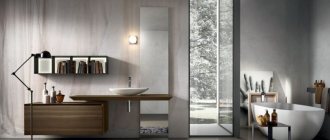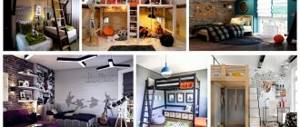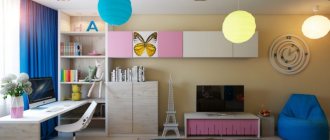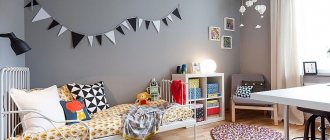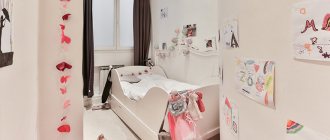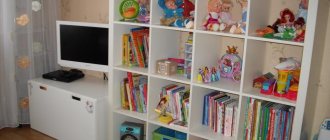The photo shows a white room without curtains with multi-colored details that make the interior original and bright.
General rules and room zoning
In order for a small children's room to look visually larger, you need to follow several rules:
- Light color palette (pastel wallpaper with or without a pattern, glossy white ceiling, do not use more than three colors to create an interior). Bright accents are appropriate for children under 7 years of age and more subdued ones after 9 years of age.
- Choosing vertical shelves and racks, avoiding horizontal cabinets and open shelves (narrow, tall furniture pulls up the entire space, closed doors hide all things and organize order).
- A maximum of functional things, unnecessary accessories along with toys will clutter up the empty space of the nursery. It is important to have drawers and hidden shelves for toys on the windowsill, under the bed or in the corner.
The main rule for zoning a small nursery is to place furniture near the walls to free up as much space as possible.
- The work area should be well lit by daylight and artificial light, so it is better to place the table near the window. A student needs only a small table, a comfortable chair and one small wall shelf. It is better not to choose a wide table (to save space and not to clutter the table with unnecessary items).
- The rest area or bed in the nursery should be illuminated with muted warm light for the child to fully rest; a bedside night light will help the child get used to sleeping on his own.
- The play area may contain boxes with toys, an easel or slate board, a game console and a TV, a small sofa or soft bean bag chair, a floor mat or pillows.
The photo shows the functional use of the space by the window as a relaxation area with separate lighting.
No. 2. Zoning a small children's room
No matter how tiny the child’s room is, it is necessary to place the following zones in it:
- sleep area;
- work area and creative area;
- storage area;
- a sports area and a games area, which, as the child grows, turns into a recreation area or is reserved for hobbies.
The main difficulty is that most children find it difficult to concentrate on one activity, and getting into the visibility zone of toys when the child is doing homework will provoke him to get distracted. There are a lot of examples, but the simplest solution, which designers developed together with child psychologists, is to organize the interior so that the child’s field of view includes things that are related to what he is doing at the moment. This is why it is so important to create separate areas for study, play and sleep, as well as to highlight their boundaries.
The zoning objectives are best met by arranging furniture around the perimeter of the room . This layout is also convenient from the point of view of freeing up space for outdoor games in the center of the room. It is best to highlight zones using finishing colors or lighting.
Choosing an interior style
In order for the nursery to look relevant for as long as possible, it is worth decorating it with toys and accessories that are easy to replace. The room can be designed in different styles using a play of colors, textiles and decor.
- The modern style of a children's room implies the presence of functional furniture, a transformable bed or a special set where the bed occupies the second floor and a small sofa or table is located under it.
The photo shows a room for two, where the workspace is enlarged due to a corner table, and the relaxation area is occupied by a bed on the second level and a folding sofa.
- The nautical style in the nursery is suitable for both boys and girls; it is decorated in blue tones, with white furniture, fittings in the form of shells and boats.
- Scandinavian style involves open cabinets, white colors, knitted blankets, light curtains and wooden floors.
- In a classic children's room, a sliding wardrobe replaces a tall chest of drawers, the walls are painted in a delicate blue or beige color. Classics are created by gold fittings, frames with photographs, a lambrequin and a canopy.
- Provence is suitable for decorating girls' rooms. Wallpaper with small flowers, shortened simple curtains, carved furniture and fresh wildflowers will create the coziness of the French style.
Differences in the design of a boy's and a girl's room
10 years ago, modern interior design was just gaining momentum in Russia, but even then experts strongly recommended separating the principles of room design for girls and boys.
Room design for a girl
Speaking of colors, it is better to use white, peach and pale green tones in combinations. Minimum contrast in combinations. The most suitable style is “Provence” or “Romantic”.
Furniture in the interior of a children's room for a girl (10 years old, for example) should not only be beautiful and original, but also practical, because after this age, the desire to expand her wardrobe especially increases.
Boy's room design
Boys are slightly different in the way they think and relate to their surroundings. Psychologists recommend paying attention to the following points in design:
- When it comes to color design, it is better to give preference to a more saturated and contrasting option. The most suitable colors are shades of blue, lilac (with yellow, for example) or green.
- The style is suitable “High-tech”, with a wide area for working with a computer.
- Children's furniture for a schoolboy should be practical and conservative, without toy cars - this provokes a lack of seriousness and impedes the development of pragmatism.
- Furniture for a children's room for a school-age boy should also be arranged rationally - for example, it is better to separate the study area with a relaxation area, since the availability of a computer before bedtime can reduce the desire to relax.
And of course, it is important to remember about accessories - funny inscriptions on the cabinets, a set of rules and daily routine in a beautifully designed style, children's drawings by a schoolchild and a variety of literature will help the owner to love and accept his room.
Color solution
When choosing a color, the main thing is not to overdo it with bright accents, which will make a small space even smaller. For a newborn's nursery, cream, turquoise, light gray and white shades of walls are suitable, which will be combined with pale yellow, tangerine, and soft pink.
The photo shows a children's room for a baby in gray and white with pale yellow accents.
You can traditionally decorate a nursery in pink or blue, but the following combinations for a boy’s room look much more interesting:
- Gray-white walls and yellow interior details;
- Gray walls and blue and white details;
- Turquoise-white walls and natural wood color;
- Blue and white walls and red accents;
- White walls and green and orange accents;
- Green and white walls and natural wood color.
For a girl's nursery:
- Gray-pink pastel shades for walls and white decor;
- Beige walls and soft pink accent in textiles;
- Gray walls and tangerine decor;
- Gray walls and fuchsia color in the interior;
- Beige walls and turquoise accents.
The photo shows a small modern girl’s room in gray and pink with ergonomic furniture and proper lighting.
Color scheme: versatility or princess boudoir
Many children's rooms for girls are made in pink tones, but, as practice shows, pink colors quickly become boring. The best option for decorating the interior of a small children's room for a girl is pastel colors such as peach, milky, pale lilac, beige, lavender and olive. To prevent the interior from looking faceless, it can be complemented with bright accents. For example, you could make three walls a neutral color and one wall a bright color. Hand-painted walls look original. If mom or dad have artistic talents, then the nursery is the place where they can be fully realized.
A little girl is unlikely to like a monochromatic stylistic solution and faceless space. For a child, such a design will be very boring. So how do you find a compromise? A bright accent can be textile elements, curtains and carpets. In addition, psychologists have proven that young children like bright colors, but schoolchildren already prefer calmer shades. If you choose an option with calm wall decoration and bright textiles, then changing such a room to suit a grown child is as easy as shelling pears. Changes to a room can be done without much expense. And the walls can be transformed with the help of self-adhesive stickers, which can be changed as soon as you get tired of them.
It is better to leave the ceiling with the usual white light; this will visually expand the room and also will not distract the child. It is better to choose light-colored floor coverings that are a shade lighter than the wall coverings. This will visually increase the boundaries of the room. A child’s room for a girl is a reflection of her inner world, don’t forget about it.
Finishing requirements
All materials for finishing and arranging the nursery must be environmentally friendly and not emit harmful substances or strong odors.
- Walls. For smooth walls, a special water-based paint is suitable, which adheres well and dries quickly. As your child gets older, you can repaint the walls over the old paint and change the style of the room. You can use paper or non-woven wallpaper that will hide the unevenness of the walls.
- Flooring. A laminate with a slight roughness is suitable for the floor so that the child does not slip. Cork flooring, which is very warm and non-slip, is also a good choice. It is better to abandon massive carpets and rugs as dust storage; a small carpet made from natural materials will do. If you choose linoleum for a nursery, it should be without synthetic materials.
- Ceiling. Whitewashing or painting will do; you can make a suspended single-level glossy ceiling that reflects light and further enlarges the small area.
The photo shows a white nursery with a red and blue accent on the wall and in textiles. A small room looks wider due to the mirror.
Furniture selection
Transformable furniture or modern compact furniture will help organize a play, relaxation and study area for your child. Designers offer a large selection of furniture designs, where the bed is combined with a table, shelves and drawers, freeing up space for games and additional interior items. Furniture for a small nursery should be made of light wood or painted in light shades (milky, white, light beige, etc.).
One sliding wardrobe will help save space in a small nursery and additionally replace a couple of shelves, and a large mirror built into the wardrobe doors will create the illusion of the width of the room.
It is better to choose a bed for growth, a regular adult size, and organize a second floor for games or storing things. The bed can also be a chest of drawers, which has pull-out shelves at the bottom. A pull-out bed, a chair-bed, and a folding sofa will also save space in a small nursery.
In the photo there is a nursery for a boy in blue, where all the furniture is used rationally.
It is recommended to take a desk and chair of adjustable height. For compact placement, shelves and racks occupy both sides of the table. There are also ready-made sets where the bed is located above the table, thus combining two zones on one wall.
Royal treasures: or storage system
A girl, as a future housewife, needs to be instilled with neatness from childhood. Therefore, storage systems should be organized so that the young owner can clean up her room herself. The nursery should not turn into a warehouse and a center of chaos. Each thing should have its own fixed place. This will help the girl easily navigate her space and not turn out closets looking for things she needs.
Even in the smallest children's room, storage systems must meet the following principles:
- The child should be able to easily reach the clothes in the closets. The upper shelves can be used to store seasonal clothing.
- Dressers and chests store things that a child uses in everyday life.
If you combine a tall wardrobe and a chest of drawers, then it is better to place the wardrobe against the wall in the corner, so it eats up less space. In the child's room there should be only those things that he uses. Otherwise, sooner or later the room will turn into a warehouse of unnecessary things with endless chaos, which depresses both parents and children.
Choice of lighting, decor and textiles
When choosing lighting for a nursery, it is recommended to choose several light sources:
- For the main lighting, you should choose not a chandelier, but built-in spotlights with adjustable brightness above the work area (the light should diffuse gently and not be cold).
- A fluorescent desk lamp is a must on every schoolchild's desk.
- A small wall-mounted night light by the bed in the nursery will help your child fall asleep.
Decorating a small room should be done to a minimum and taking into account the age characteristics of the child. For example, in a children's room for a boy under 12 years old, a pirate, racing theme and a well-equipped sports corner (a ball ring or a hammock) will always be relevant. To design a nursery for a girl, it is important to have a large mirror, small pillows, a canopy, and paintings.
It is better to choose bed linen from natural fabric in a neutral color or with thematic patterns.
For window decoration, light curtains, Roman and French curtains, blinds, tulle and translucent fabrics are best suited for convenient use of the window sill as additional storage space. In terms of color, it is best to focus on curtains, bedspreads and a rug (as the child grows older, they are easier to replace than, for example, a stretch ceiling fabric).
The photo shows a teenage children's room with glossy furniture, a lush pouf and roller blinds. Horizontal stripes on the wall make a small room visually wider.
Room for two or three children
If it is not possible to allocate a room for each child, then you can divide a small children’s room for two children into personal zones. In one closet, everyone will have their own shelf, there will be two approaches to the desktop, everyone should have their own chair (if both children are schoolchildren). If these are children of different sexes, then it is better to choose a bunk bed with curtains.
The photo shows a children's room for two, where the color accents are panels of cool shades, a decorated chandelier and textiles.
For three children, a bunk bed and a chair-bed with a comfortable mattress are suitable. It is important to organize a mode for comfortable use of zones, for example, the order of classes at the table and the organization of lighting in such a way that the student does not disturb the rest.
Ideas to help expand the space of a small nursery:
- Refusal of massive and long curtains in favor of roller blinds in order to use the window sill as a shelf or an additional workplace;
- To save space, you can make a retractable or small folding table;
- Light finishes, good lighting, mirrors and a glossy stretch ceiling will increase the space;
- Selection of functional furniture (for example, modern small cribs for newborns transform into a full-fledged bed).
How to properly zone a children's room?
When designing a child's room, critically evaluate the size of the space.
At first glance, a small children's room can only serve as a bedroom - organizing a play area and a study and work space for your schoolchild here may not be easy, but it is possible! For example, when designing a room for two, you can save space by incorporating a second level by installing bunk beds. Or, if you have one child, you should consider a loft bed, under which a spacious wardrobe or small sofa can easily fit, but it is better not to place a table for lessons under the bed - move it closer to the window. If you are renovating a room for two children, make sure that each of them has their own personal space. Even if we are talking about an unusually designed wall next to the head of the bed. In any case, the decor of the nursery should emphasize the interests of the child. Listen to your child’s wishes, look for new ideas and don’t forget to use photos for inspiration when creating a children’s room design. If you are just looking for ideas for renovation and arrangement or already know for sure that a children's room is your option - we have collected for you 159,819 photos from real projects of interior designers, decorators and architects from Russia and around the world, including such proven professionals as ART4INTERIOR and Architectural studio Astar project. The beautiful children's rooms in our photographs are the best examples of competent design and layout in different styles and colors. If you like any design option, for example, the children’s room from the second photo, you can contact the author and order the ideal design project for yourself. See our photo gallery, look for inspiration and professionals, and you will see why Houzz is the best resource for apartment and home interior design, renovation, home construction, architecture and landscape design.
